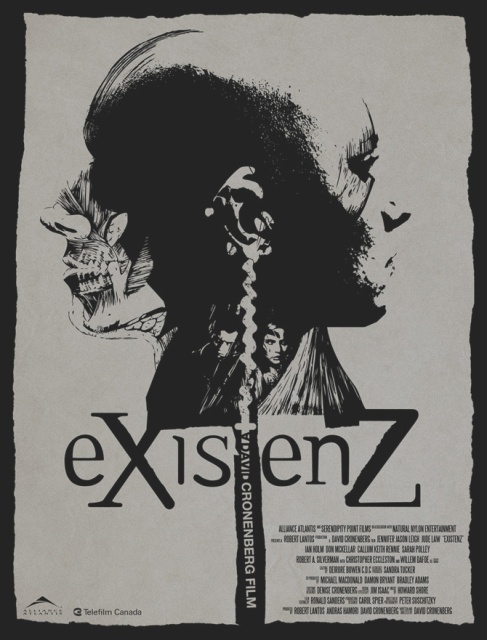David Cronenberg’s eXistenZ is a condemnation of virtual constructs and a diagnosis of the sickness that exists as an organism reproduces their reality in great likeness. Throughout the picture there is a sense that at any given moment your perception can shift. Once reality is compromised in the first place, there is no end to how detached one can become from existence.
The film begins at a private debut of the new VR game eXistenZ. Certain people are in the first wave of twelve to get out their bio-pod, (more on this later), and plug in. As Allegra Gellar, the game’s programmer, leads the first wave into the game, there is an assassination attempt on her life. This leads her to escape with a security man, Ted Pikel. So far, the film has portrayed the game designers as victimized and on the run.
Pikel digs a bullet out of Gellar’s arm. It is a human tooth. The gun was made of bones and skin and shot teeth. It was completely organic so as to get through security. Here Cronenberg is making a value statement about flesh and bone vs. technology. The strong flesh and bone are the only source of resistance against the impending digital worlds.
She needs someone she can trust to plug into eXistenZ with her to make sure the game isn’t compromised. Pikel needs a bio-port so they stop at a Mechanic shop. Willem Dafoe worships Gellar. She invented a game called Art God in which one plays God the creator/Artist. It changed his life. We are comparing the artist to god, not just as a video game designer, but even begging the question, does not the novelist, painter, filmmaker act as the Art God? Do they determine all parameters of their work? Later in the film Gellar refers to the game as, “Free will disguised in a deterministic reality”. If we can be sold this believably at any point, how can we ever trust the chaos of natural reality? How do we know it isn’t all determined?
Cronenberg is just having a bit of fun casting Jesus as the manipulative mechanic who installs Pikel with a bogus bio-port. He betrays Gellar and Pikel and they escape, only to have their slave-pods blown by the port. What the fuck does this all mean? Slave pods? Yup. Cronenberg straight up calls video game controllers slave pods. Sure, their made of mutant amphibian insides and you plug them into your spine but all they same they are video game controllers. SLAVE PODS. These are the tools of self-enslavement. Plug in and the real world doesn’t have to worry about you till you re-surface.
These fleshy lumps are biological in nature and you plug them into your back. Pikel feels a bit violated when Gellar plugs into him. She licks the plug and fingers the hole in Pikel’s back. This stuff feels incredibly pornographic and inverted. A woman plugs the child of her consciousness into a man. Not only are we reversing penetration, with the woman entering the man, also, the fruit of her labor is going into the man, and he absorbing it into his mind. Cronenberg is detailing and deconstructing the mirage of the birth myth. Here gender is meaningless, here births happen inside your mind and anything is possible.
As I said before, the port blows the pod, the myth of Jesus the Mechanic proving unpalatable, we move on to another bit of casting fun, Ian Holm as a Port Fixer/Engineer. This is ironic because Holm’s most iconic role is that of Ash the betraying Android from Alien. Turns out, in this movie, he’s a good guy, or at least installs a valid port. And now we get to the part of the movie where they finally play eXistenZ. This stuff is interesting based on the shift at the end. But as it is, the game is virtual and Gellar and Pikel have seeming freedom, but occasionally the game will take over and have them say certain lines to advance the program or give them sexual urges to heighten emotion in game play.
Here a game of cat and mouse begins, Pikel assassinates his contact or does he? The game confuses and confounds the players until they don’t know whom they are playing for, whom the empire or the rebellion is and ultimately Gellar betrays Pikel. And they wake up, players in a game called tRancendEnz. Jennifer Jason Leigh and Jude Law were just playing a video game. The room applauds. Everyone fills out test cards. The games actual designers confer. They are concerned about a strong anti-gaming theme in the game.
Jude Law and JJL approach the designer and congratulate him for achieving the most effective re-creation of reality. Then they kill him and his assistant. They raise their gun at another player. He raises his hands and asks, “Wait, are we still in the game?”
This is Cronenberg’s point. Once divorced from an accepted upon reality, one can never be sure. Is the film anti-video game? I’d say pretty completely. I’d offer that the film suggests that video games are destined to become perversions of existence and worse if such a thing is possible how do we know we do not live inside of such a perversion.




